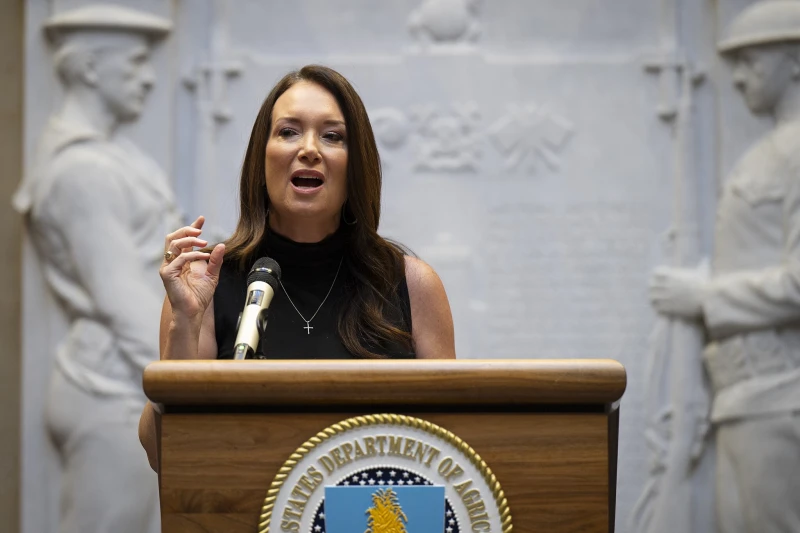

U.S. Agriculture Secretary Brooke Rollins hosts a USDA all-staff meeting on May 23, 2025, in Washington, D.C. Rollins announced the termination of household food insecurity reports in September 2025. / Credit: USDAgov, Public domain, via Wikimedia Commons
Washington, D.C. Newsroom, Oct 20, 2025 / 05:20 am (CNA).
The Trump administration’s recent decision to cease publishing an annual U.S. Department of Agriculture report on household food insecurity is being met with strong criticism by the Catholic Health Association of the United States, anti-hunger activists, and academics.
The last USDA food insecurity report, covering 2024 data, is set for release Oct. 22. On Sept. 20, the USDA, led by Secretary of Agriculture Brooke Rollins, who was appointed by President Donald Trump, announced the termination of future “Household Food Security Reports,” which were first published in 1995 during the administration of then-President Bill Clinton.
“These redundant, costly, politicized, and extraneous studies do nothing more than fearmonger,” the USDA said in a published statement.
The USDA questioned the legitimacy of the annual reports, saying food insecurity trends have remained virtually unchanged since 1995, “regardless of an over 87% increase in SNAP spending between 2019–2023.”
SNAP is an acronym for “Supplemental Nutrition Assistance Program,” which according to the USDA “provides food benefits to low-income families to enhance their grocery budget so they can afford the nutritious food essential to health and well-being.” SNAP was formerly known as the “Food Stamp Program.”
The Trump administration explained its decision for discontinuing the reports, saying: “For 30 years, this study — initially created by the Clinton administration as a means to support the increase of SNAP eligibility and benefit allotments — failed to present anything more than subjective, liberal fodder.”
Responses to terminating the report
“I don’t think collecting data about food insecurity across the country is ‘liberal fodder,’” said Lisa Smith, vice president of advocacy and public policy for the Catholic Health Association of the United States, which generally aligns with Church teaching but has clashed with the U.S. bishops in the past on health care issues, such as the Affordable Care Act. “When you don’t have the data, it makes it more difficult to know where the keys areas of need are.”
The end of the annual food security report “is going to impact the health of low-income communities,” Smith said. Smith’s concerns were echoed by Colleen Heflin, a professor of public administration and international affairs at Syracuse University and co-author of “Food for Thought: Understanding Older Adult Food Insecurity,” a book published last month along with Madonna Harrington Meyer, a sociology professor at Syracuse.
“Without national data from the Current Population Survey on food insecurity, it will no longer be possible to track year-to-year variation in food insecurity due to changing economic and policy conditions,” Heflin said. “This lack of data will make it harder for Catholic charities and other community-based organizations to effectively address food insecurity without a consistent and comprehensive understanding of how food insecurity is changing for different demographic and geographic communities.”
Like Smith, Heflin dismissed the Trump administration’s claim that the reports were little more than liberal, redundant fearmongering.
“Food insecurity data collection has been a bipartisan issue since the Reagan administration,” since the 1980s, Heflin said. Referring to the Trump administration’s plan to end the annual report, Heflin said she found “both the decision and the justification provided quite shocking and without merit.”
James Ziliak, a professor of microeconomics and founding director of the Center for Poverty Research at the University of Kentucky, told CNA that eliminating the USDA household food security reports could reduce public and policy awareness of hunger needs and hinder private-sector responses, such as those by Catholic health and social service organizations.
“This report was one of the most widely watched barometers of economic well-being among low- and moderate-income households in the U.S. and provided key information for policymakers, charitable organizations, and researchers,” Ziliak said in an email.
Like Smith and Heflin, Ziliak said he did not accept the Trump administration’s explanation for ending publication of the annual report.
“This is absolutely not justified, and the timing is especially harmful to public policy as the economy slows down and major cuts are being implemented in the largest federal food assistance program,” he said, referring to SNAP.
Read More![U.S. bishops warn of looming court order in Obama-era immigration program #Catholic
A DACA protest sign is waved outside of the White House. / null
CNA Staff, Oct 18, 2025 / 09:00 am (CNA).
The U.S. Conference of Catholic Bishops (USCCB) released an update this week on the Deferred Action for Childhood Arrivals (DACA) program highlighting the threat a looming court order may pose to the legal privileges of some immigrants in Texas.Immigrants covered by DACA who move to or from Texas could quickly face the loss of their work authorization under the new court order, according to the bishops' Department of Migration and Refugee Services.Launched in 2012 through executive action by then-President Barack Obama, DACA offers work authorization and temporary protection from deportation to undocumented immigrants brought to the U.S. as minors. The first Trump administration tried to end the program but was blocked from doing so in 2020 by the U.S. Supreme Court. While President Donald Trump has indicated a willingness to work with Democrats on the status of DACA beneficiaries, the program continues to be subject to litigation, with the latest developments centering on the Texas v. United States case.In that case, Texas sued the federal government claiming that DACA was illegally created without statutory authority, as it was formed through executive action rather than legislation passed by Congress.In January, the Fifth Circuit Court of Appeals largely upheld the U.S. district court’s declaration that DACA is unlawful, but narrowed the scope to Texas, separating deportation protections from work authorization. This means, in theory, that DACA's core shield against removal could remain available nationwide for current recipients and new applicants, while work permits might be preserved for most — except in Texas. Impending implementation The USCCB's Oct. 14 advisory comes as the district court prepares to implement the ruling upheld by the appeals court. On Sept. 29 the U.S. Department of Justice issued guidance concerning how the order should be implemented. Andrew Arthur, a former immigration judge and a fellow at the Center for Immigration Studies, told CNA that the key takeaway from the USCCB’s update is a “warning” to DACA recipients “who live in Texas.”"[A]nyone who has DACA or is eligible to receive it would need to consider the implications of moving to or from Texas," the USCCB update states, pointing out that relocation could trigger revocation of employment authorization with just 15 days' notice. For Texas's approximately 90,000 DACA recipients — the second-largest population after California's 145,000 — the implications could be stark, according to the bishops. Under the order, if it is implemented according to the U.S. government’s proposals, DACA recipients who live in Texas could receive "forbearance from removal" (deferred deportation) but lose "lawful presence" status, disqualifying them from work permits and benefits like in-state tuition or driver's licenses. To be eligible for DACA, applicants must have arrived before age 16, resided continuously since June 15, 2007, and been under the age of 31 as of June 15, 2012. There are approximately 530,000 DACA participants nationwide according to KFF, formerly the Kaiser Family Foundation. The KFF estimates that up to 1.1 million individuals meet DACA eligibility criteria.](https://unitedyam.com/wp-content/uploads/2025/10/u-s-bishops-warn-of-looming-court-order-in-obama-era-immigration-program-catholic-a-daca-protest-sign-is-waved-outside-of-the-white-house-nullcna-staff-oct-18-2025-0900-am-cna-the-u.webp)
















